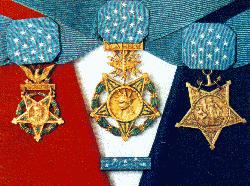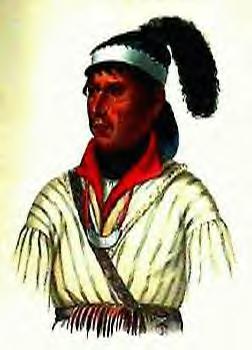|
|
Canku Ota |
|
|
(Many Paths) |
||
|
AN Online Newsletter Celebrating Native America |
||
|
april 7, 2001 - Issue 33 |
||
|
|
||
|
This Date In |
||
|
North American Indian History |
||
|
from On This Date in North American Indian History at http://americanindian.net |
||
| Apr. 7, 1984: | The first meeting between the eastern and western CHEROKEES since the 1800s is held today. |
| Apr. 8, 1944: | Ernest Childers gets the Medal of Honor today. A Creek from Oklahoma and a First Lieutenant with the 45th Infantry Division during World War II Childers received the Medal of Honor for heroic action in 1943. Up against machine gun fire, he and eight men charged the enemy. Although he suffered a broken foot during the assault, Ernest ordered a cover fire, then advanced up the hill, single-handedly killing two snipers, silencing two machine gun nests, and capturing an enemy mortar observer. |
|
|
|
| Apr. 9, 1884: | A woman, identified by local missionaries as Sacajawea, dies today in Wyoming. If this is the Sacajawea of the Lewis and Clark expedition, she would be almost 100 years old. |
| Apr. 10, 1830: | The first wagons appear on the Oregon Trail. |
| Apr. 11, 1968: | The American Indian Civil Rights Act is passed. |
| Apr. 12, 1886: | Due to General Crook making an agreement with Geronimo about his surrender terms which his supervisors would not honor, Geronimo does not surrender. This angers Washington, and Crook is replaced on this date by Nelson "Bear Coat" Miles. Miles will eventually take a large force into the field to hunt down Geronimo and his 24 holdouts. |
| Apr. 13, 1946: | Congress will create the Indian Claims Commission today. The commission is established to hear and decide claims made by Indians based on land losses from treaties. |
| Apr. 14, 1614: | John Rolfe marries Pocahontas |
|
|
|
| Apr. 15, 1834: | Lt.Joseph Harris is leading approximately 500 to 600 CHEROKEEs to Indian Territory. They have reached the juncture of the Arkansas and the Cadron river, about 25 miles northwest of Little Rock. The river is very low, so they are making no headway in their boats. The CHEROKEEs get off the boats top wait for the river to rise, or, for the impatient, to travel overland. For those waiting for the river to rise, a virulent form of cholera strikes. As many as a dozen Indians would die each day for several days. Eventually, they will start moving overland toward the Indian Territory. They will reach their new lands on May 8. |
| Apr. 16, 1550: | Charles V orders a stop to Indian land conquests. |
| Apr. 17, 1680: | Born near modern Auriesville, New York, in 1656, Tekawitha, was the niece of a MOHAWK Chief, who raised her after her parents died. See eventually met a Jesuit missionary, who baptized her as Kateri (Catherine). She was shunned by her MOHAWK tribe, and she moved to a village of IROQUOIS Indians in 1677. It was at this time that she became a Catholic nun, the first of her tribe to do so. She died on this date. Many cures were attributed to prayers made in her name. She was recommended for canonization in 1844, and she was beatified in 1980. |
| Apr. 18, 1879: | After the Custer disaster, the U.S.government decided to punish the plains Indians. While the PONCAs had no part in the Custer battle, the had erroneously been placed in a reservation with the SIOUX. When it was decided to force the SIOUX to go to Indian Territory (Oklahoma), the PONCAs were ordered to go as well. Many PONCAs started to walk back to their old reservation from Indian Territory. Eventually, General Crook would sympathize with the PONCAs and one of their Chiefs, Standing Bear. Seeking public support to avoid being ordered to sending Standing Bear back to Indian Territory, General Crook contacted the press about the PONCAs' plight. Many editorials were written in support of the PONCAs, and several lawyers volunteered their services for free. Judge Elmer Dundy, with Crook's blessing, issued a writ of habeas corpus to the General to produce the PONCAs and show why he held them. A U.S. District Attorney argued that the PONCAs could not be served a writ because they had no legal standing , or were not recognized as people, under the law. On this date the tribe began to determine if Indians, and particularly Standing Bear, were people under U.S. laws and could enjoy constitutional rights and privileges. The judge would eventually rule that Standing Bear was indeed a person and could not be ordered to a reservation against his will. While this decision would seem to prevent keeping any Indians on any particular reservation against their will, the eventual course of the U.S. Government was to say the ruling applied only to Standing Bear, and to no one else. |
|
|
|
| Apr. 19, 1842: | Mikasuki SEMINOLE Hallack Tustenuggee is Chief of one of the last groups of SEMINOLEs still fighting American forces. Today, his band will engage 400 soldiers, under Colonel William Worth, near Lake Ahapopka, Florida. Leaving their provisions behind, many of the SEMINOLEs will escape. Many historians will consider this to be the last battle of the Second SEMINOLE War. |
|
Hallack Tustenuggee |
|
| Apr. 20, 1988: | The "Termination Resolution" repealed today. |




